Пример фотографического проекта/исследования
Продолжаю получать просьбы о том, чтобы размещать здесь учебные материалы. Привожу прекрасный пример проекта, который мог бы выполнять каждый, кто хочет развиваться в понимании фотографии.
Аспирант делает проект по истории моды и изучает куда уходят корни фотографии моды, подбирая фотографические пары и снабжая их небольшими поясняющими текстами. Каждый может выбрать себе тему по душе и делать все тоже самое по аналогии.
Ссылка: http://partnouveau.com
Несколько примеров (полные изображения можно найти на сайте по ссылке, там примеров гораздо больше, чем здесь):
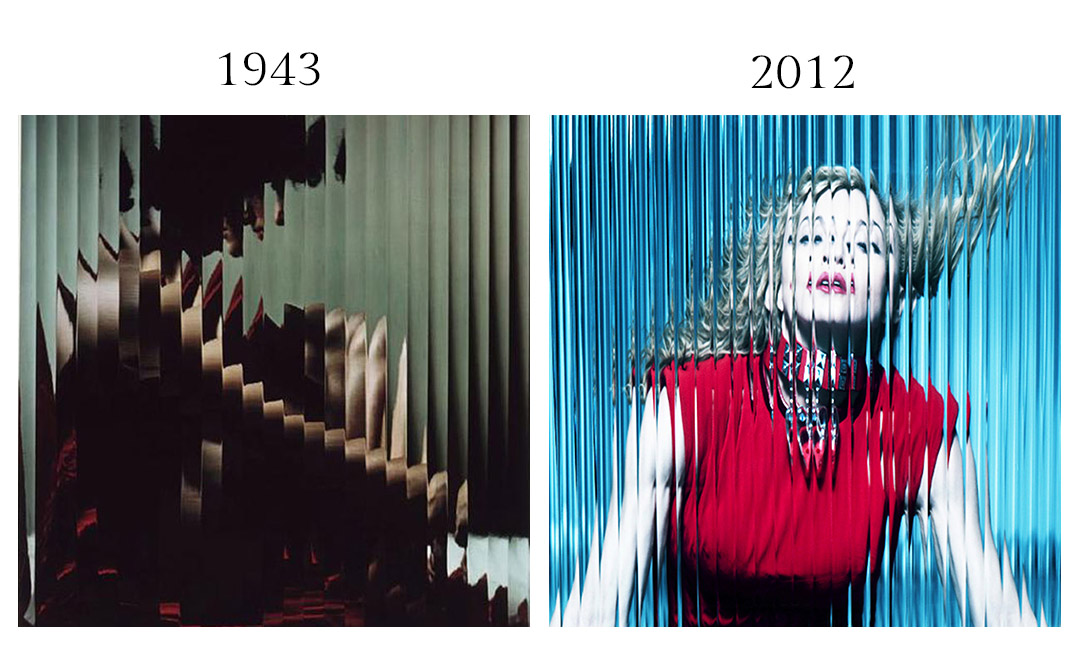
German photographer Erwin Blumenfeld’s Dada background is evident in his collage-like images and photographic manipulations. In 1943, Blumenfeld would place model Lisette behind a full-length panel of fluted glass, photographing her rippled, fragmented silhouette. In 2012, photographer duo Mert Alas and Marcus Piggott would employ a similar tactic in photographing Madonna’s MDMA Album cover.
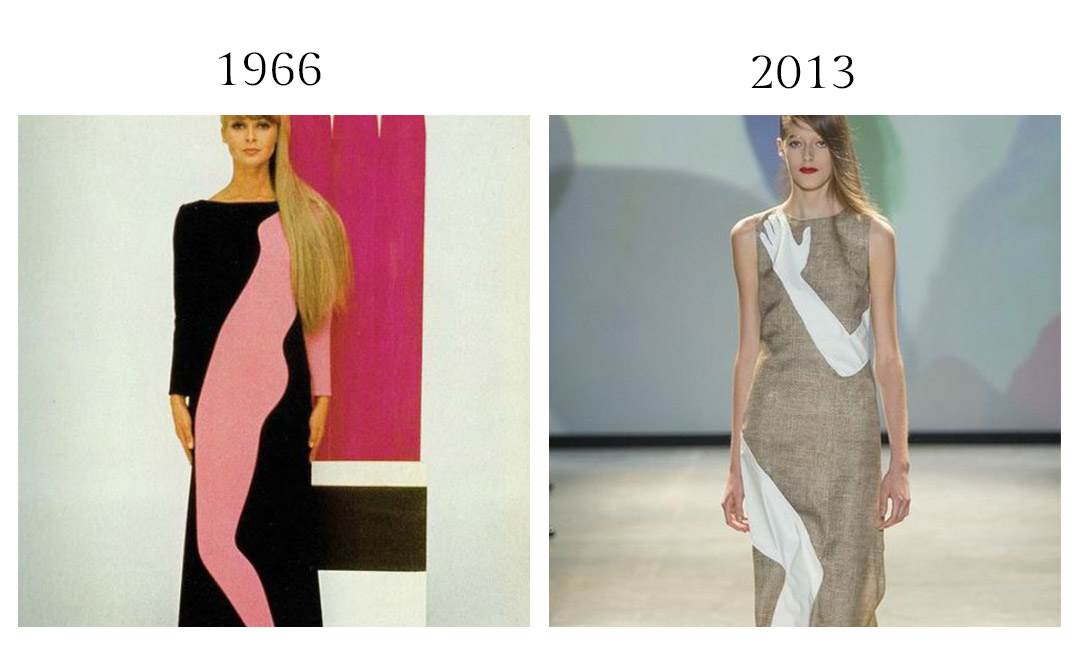
A year after Yves Saint Laurent debuted his Mondrian-inspired shift dresses, the designer continued his appropriation of art into fashion with his Fall/Winter 1966-67 “Pop Art” dresses. This crop of dresses featured fragmented silhouettes of the female figure printed atop columnar shaped gowns, perhaps suggesting the nude body beneath the cloth. For Jean Charles de Castelbajac’s SS 2014 show, the designer would feature a dress with an uncanny resemblance to YSL’s 1966 version.

Showcasing the president’s popularity in the entertainment world, Esquire magazine’s June 1969 cover featured the newly elected President Nixon along with his celebrity backers including Art Linkletter, Billy Graham, Rudy Vallee & Lawrence Welk. The men pictured stand with welcoming arms, wide open with optimism as they praise their new leader. To celebrate the magazine’s 75th Anniversary, in 2008 British Esquire looked back to their celebrated Art Director George Lois and recreated several of his 60s covers. Contemporary fashion designers played along in the restaged images, with Karl Lagerfeld chosen to recreate the 1969 Nixon cover. In this version, the celebrity supporters were replaced with multiple images of Karl Lagerfeld himself-perhaps to say he may be his own biggest fan.

A year before the designer’s final collection, Cristóbal Balenciaga introduced his single-seam wedding dress in 1967. Balenciaga would take cues from the period’s affinity for futuristic cuts and tech fabrics, and in this case, reappropriated them into the unlikeliest of places, the traditional white wedding dress. With just one seam, the dress suggests it was born, rather than made, void of any elements that reveal the adroit human hands responsible for its existence. A similarly smooth monastic-like hood replaced the obvious white lace veil, making for a complete space age bride. In 2008, then-Balenciaga designer Nicolas Ghesquière looked to the house’s archives and reintroduced the mod headpiece for the brand’s SS 2008 collection. Four years later, the habit-like hat was once again brought back to life by Ghesquière for Balenciaga’s SS 2012 show, this time, however, the hood was offered up as a visor and was immediately stopped atop the heads of several daring fashion week fixtures.
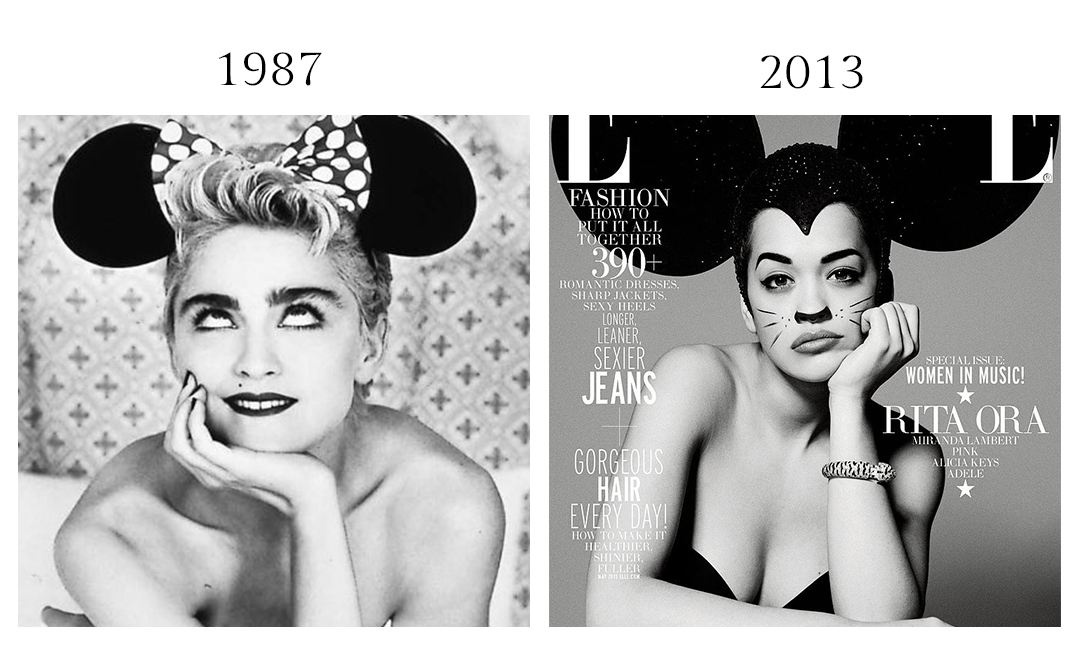
In 1987, Herb Ritts photographed Madonna in bed and undressed, save for the pair of minnie mouse ears affixed atop her head. Amused, she directs her gaze upwards, focusing further attention on the seemingly out-of-place Disney memorabilia. For Elle Magazine’s May 2013 issue, Rita Ora covers the ”Women in Music Issue” issue, similarly topped with a pair of mouse ears, however, Ora’s Philip Treacy headpiece is more Deadmau5 than Minnie Mouse.

A contemporary of Salvador Dalí and Jean Cocteau, Elsa Schiaparelli’s transgressive designs were often inspired by the surrealists. A violet, satin evening coat was the result of Schiaparelli’s collaboration with Jean Cocteau in 1937 and was almost certainly the inspiration for a jacket seen on Miu Miu’s SS 2014 runways-almost a year after the Costume Institute’s exhibition, Schiaparelli and Prada: Impossible Conversations.

Vogue’s 1966 editorial, “The Girl in the Fabulous Furs” featured 26 pages of Veruschka swathed in exotic furs, traversing about Japan on the Bullet Train, (then, the world’s fastest train) along with her stay in a traditional Japanese inn where an additional room was required to house the abundant furs brought along the journey. In the editorial, the symbolic act of cutting hair was lightly restaged with a topless Veruschka seated and ready to be rid of her long hair. Further emphasizing the impact of a model’s change of appearance, Patrick Demarchelier documented Karlie Kloss’s transition from a long haired ingénue to a sophisticated gamine, which swiftly prompted several models and subsequently countless fashion conscious individuals to chop off several inches of their own hair.

Irving Penn and Mario Testino
With the return of the midi skirt, along with Raf Simons citing the Dior archives as the predominant inspiration behind his latest collection for the house, it seems a sense of mid-century glamour is having a moment. As Vogue’s leading photographer, Irving Penn’s sharp postwar imagery pierced the pages of the magazine in his signature high-contrast, black and white imagery. Penn’s unforgettable cover for the magazine’s April 1, 1950 issue features an immaculate Jean Patchett, enveloped in net and wrapped in a scarf, much like a life-sized New Look Barbie. For Vogue China’s December 2013 issue, Mario Testino would look back to Penn’s oeuvre with an editorial reminiscent of Penn’s early work at Vogue. Model Shu Qi plays the role of Jean Patchett, restaging some of Penn’s most well-known.

Inspired by Pina Bausch’s Ballet Keuschheitslegende, in which life-sized crocodiles creep around onstage amongst dancers, Helmut Newton would capture a ballerina-quite literally-in the belly of the beast, taking the transgressive ballet just a step further. For Vogue China’s 10th Anniversary issue, Mario Testino would photograph model Liu Wen also interacting with a crocidile, however, in the contemporary version, the woman seemingly dominates the animal rather than serving as its prey.
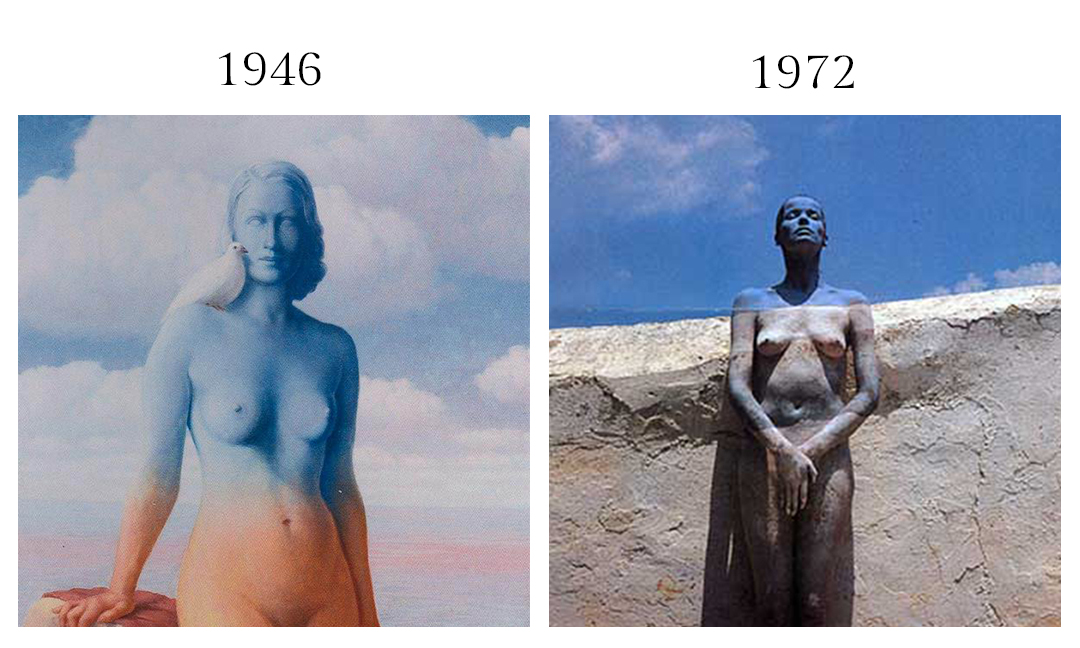
Belgian artist René Magritte toyed with perspective and reality, creating surreal works through real, ordinary settings and mundane objects. A common theme in Magritte’s work included the unsuspecting use and placement of clouds with an indistinguishable divide between grounded reality and fantastical skies. A Holger Trülzsch photograph of Veruschka from 1972 bears significant resemblance to Magritte’s 1946 work La magie noire.
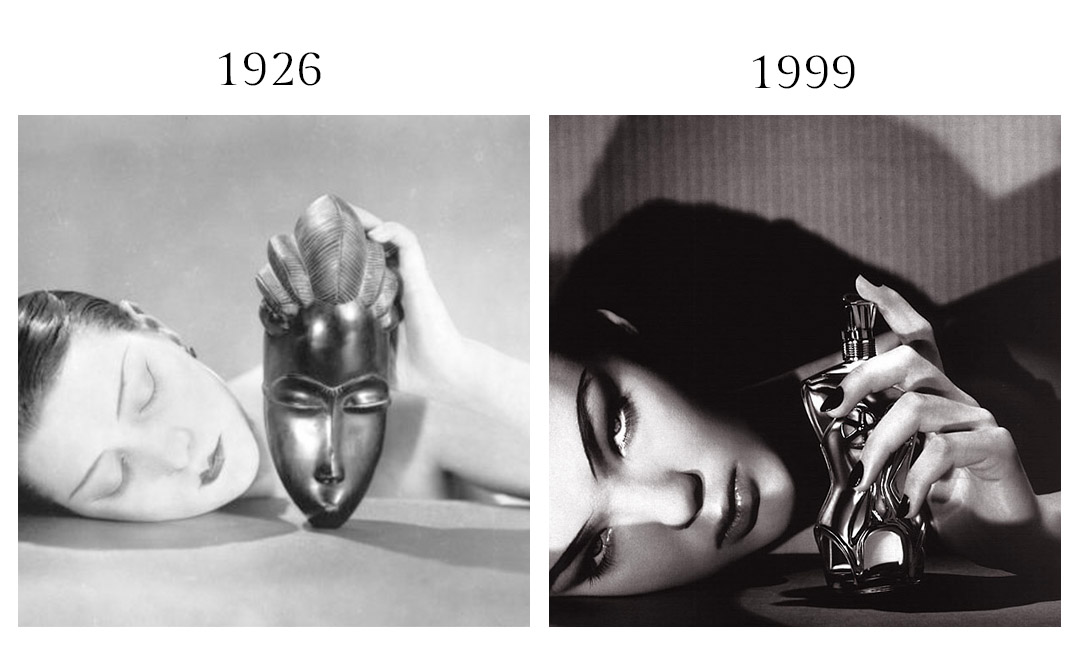
A proponent of the Surrealist and Dada movements, Man Ray would build a prolific body of work as an artist and photographer. In 1926, Man Ray photographed Alice Ernestine Prin, better known as Kiki de Montparnasse, a social fixture of the Parisian bohemian scene of the 20s (and yes, the same Kiki who would later inspire the eponymous, uber-sexy lingerie brand). Representing the surrealist’s affinity for African Art, the photograph features Kiki’s resting head alongside that of a tribal African mask. Years later, the seminal Man Ray photograph would serve as inspiration to a fragrance campaign for Jean Paul Gaultier’s signature Classique. Photographed by Jean-Baptiste Mondino, the ad is currently on display at The Fashion World of Jean Paul Gaultier: From the Sidewalk to the Catwalk at the Brooklyn Museum.

As the uni-sex ruff became an increasingly pervasive component of Renaissance dress, women made an alteration to the demure neckpiece creating the open ruff as an alternative that showcased the woman’s bust. For Thom Browne’s SS 2014 collection, the designer would reappropriate several elements of historic costume including the women’s open ruff.
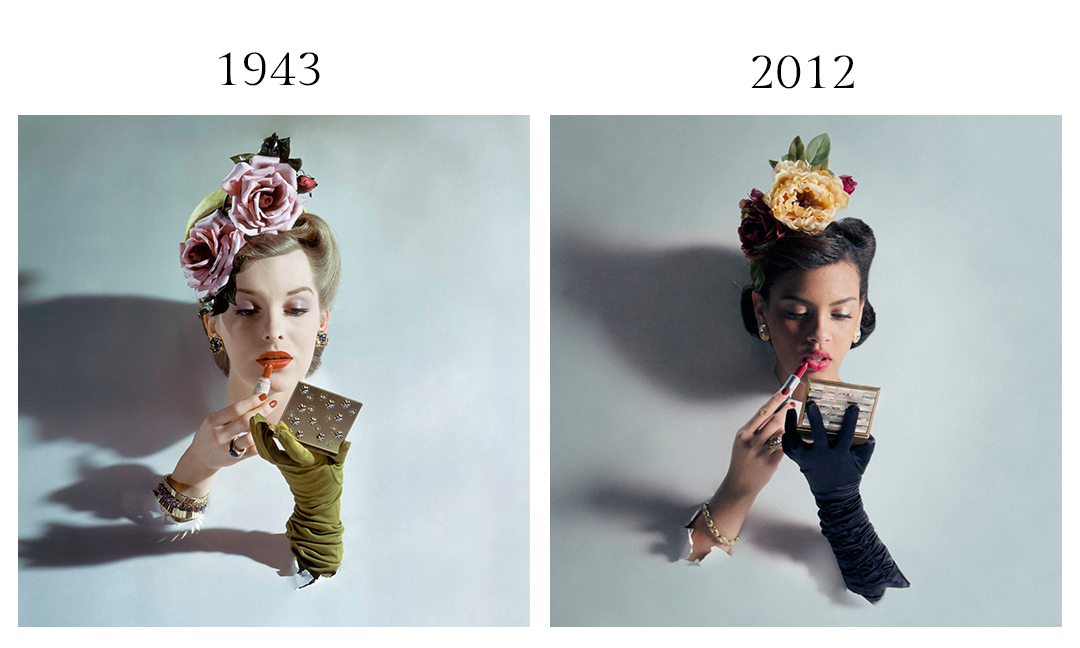
Fashion coverage throughout WWII placed high value on accessories amongst the wartime rations. When a new dress was not an option, the resourceful woman would change the ribbon on her hat to maintain a fresh look. With such focus placed on the trimmings of an ensemble, photographer John Rawlings would photograph just that with the amply accessorized hands and face of a disembodied model seemingly appearing out of nowhere.
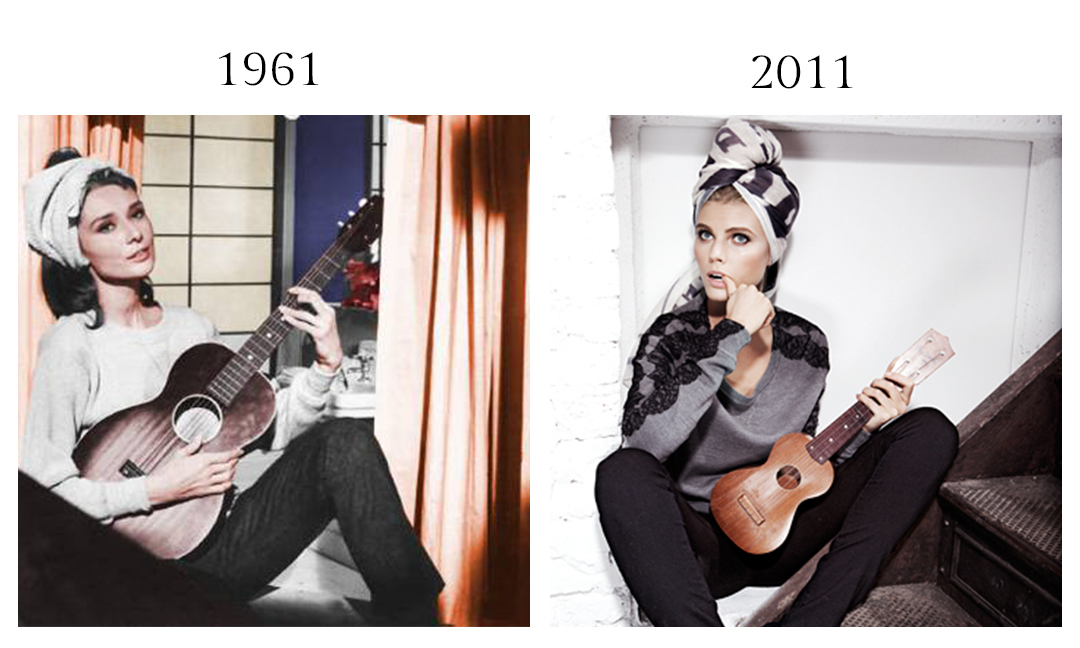
A film that ranks top tier in any fashion lover’s list of all-time favorite films, Breakfast at Tiffany’s has provided endless source of fashion inspiration to designers and photographers. To this day, the film holds clout amongst the sartorially-minded and maintains an enduring ability to generate buzz. For Glamour Russia’s September 2011 issue, photographer Kenneth Willardt photographed model Maryna Linchuk posed as some of Hollywood’s most remembered leading lady protagonists, re-staging Breakfast at Tiffany’s brief music sequence in which a casual Holly Golightly sits perched atop her fire escape whilst serenading her neighbors with Moon River.

Following Man Ray’s lead, Philippe Halsman was a proponent of surreal photography with his elaborately orchestrated surreal scenes including his 1949 work Popcorn Nude recreated by Tim Walker in 2008. Walker often restages well-known photographs, adding his signature whimsical style to the overall composition. In this version, Halsman’s black and white is substituted with unexpected color in the least likely of places for Vogue UK‘s December 2008 issue in the editorial “Tales of the Unexpected,” which paid homage to Roald Dahl, creator of the most beloved children’s tales of the 20th century.

Following Man Ray’s lead, Philippe Halsman was a proponent of surreal photography with his elaborately orchestrated surreal scenes. Most remembered for his portraits of Albert Einstein and fellow surrealist Salvador Dalí, the Latvian-born Halsman would also photograph contemporary fashion. In 1947, Halsman would photograph the fall footwear fashions, depicting three pairs of disembodied legs sporting the latest shoe styles peeking out from underneath a curtain. In 2011, Karl Lagerfeld would photograph model Freja Beha in her the fifth consecutive campaign for Chanel. In the ad, only Beha’s stockinged legs are visible beneath the curtain of a photo booth, resembling Halsman’s photograph years earlier.

According to imperial dress codes under the Qing Dynasty, court officials and bureaucrats would don required red caps known as “Rites Hat.” Two styles of the hat were worn, the Nuan Mao and the Liang Mao, the former reserved for summer, consisting of a conically shaped red cap and the latter worn during winter featuring a black fur brim as pictured in Emperor Xianfeng’s portrait c. 1855. For his Fall 2012 collection, designer Jason Wu looked to his Chinese heritage, incorporating elements of Chinese traditional dress into his ready to wear collection.
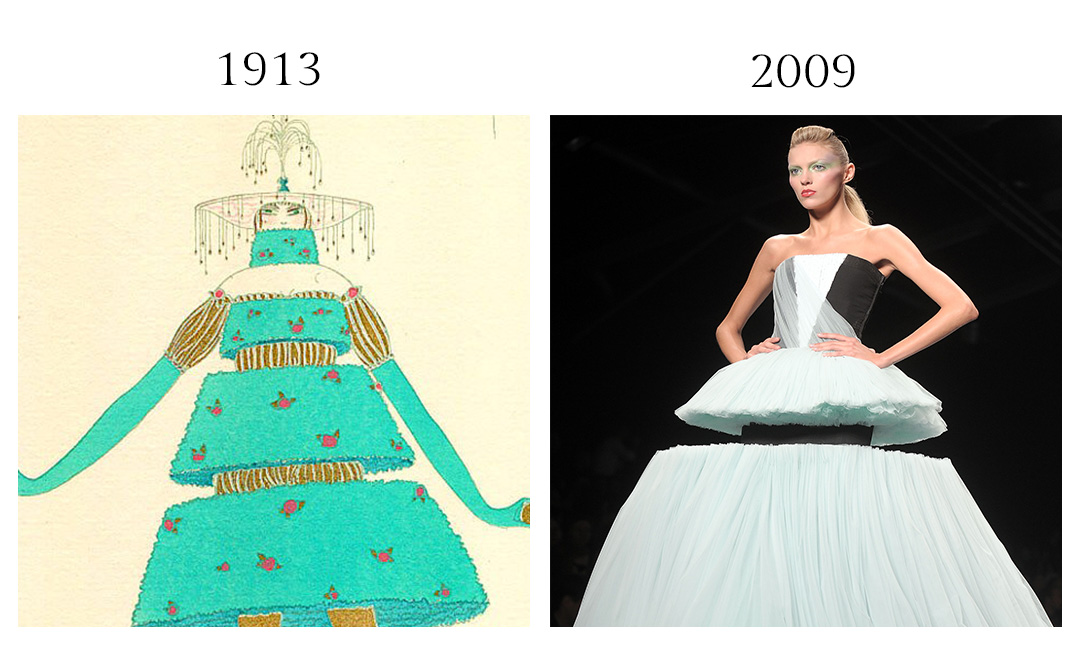
A precursor to the contemporary crop of limited edition, collectable publications, La Gazette du Bon Ton, or the Journal of Good Taste, boasted hand-colored fashion plates and exclusive designer features at the steep annual subscription fee of 100 francs per year for the monthly publication. Along with the designs of couture houses Redfern, Doucet and Pacquin, orientalist designs by Paul Poiret were a frequent feature in the journal. Often times the fashions found in the Gazette were fanciful creations by illustrators like Georges Lepape, rather than literal translations of existing garments. Lepape’s fantastical fashion plate in 1914 depicts a Poiret dress in the style of the Sun King’s manicured garden’s. For their SS 2010 collection, Vikor and Rolf would design a similar dress that explored concepts of cutting down, shaving and trimming-taking a chainsaw to tulle.
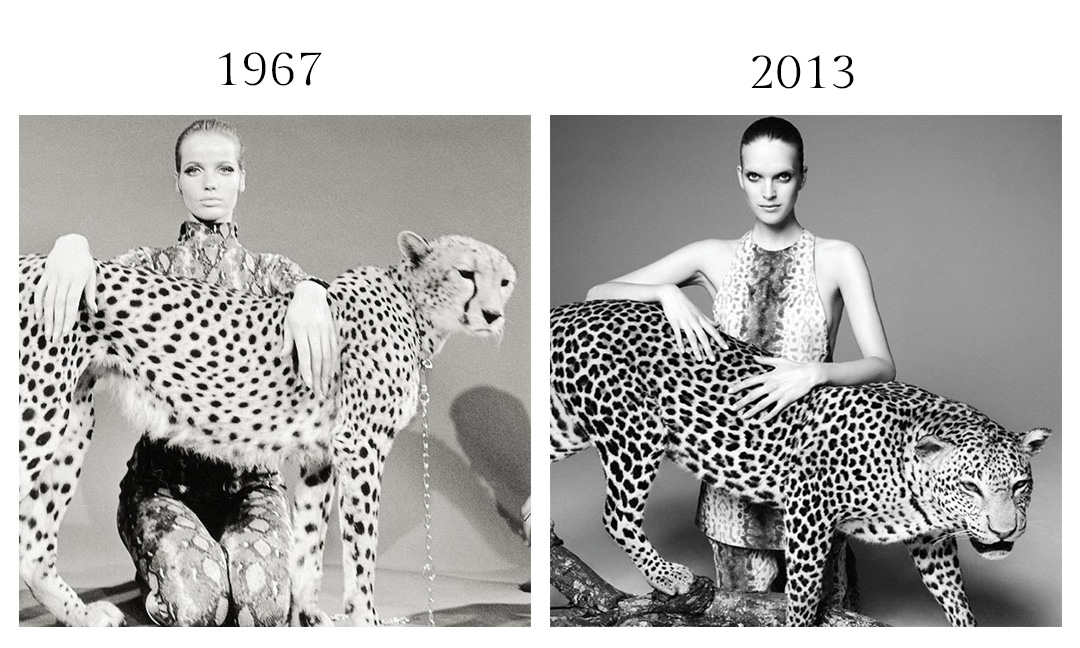
Although his work often made up the pages of Vogue, William Klein rejected the label of fashion photographer, perceiving the association limiting and misrepresentative. Klein was also a painter, filmmaker and photographer with a somewhat cynical view of fashion; in 1966, Klein’s would famously satirize the cult of fashion in his film Qui êtes-vous, Polly Maggoo. In spite of this, Klein would go on to produce remarkable fashion imagery. For Vogue‘s July, 1 1967 issue, Klein would photograph the self-proclaimed ”exotic” model Veruschka alongside a chained cheetah to showcase two trends of the season: chains and animal skins. For Vogue Latin America‘s June 2013 issue, photographer Nagi Sakai celebrated the German model’s career by restaging several of her most well-known images with model Mirte Maas.
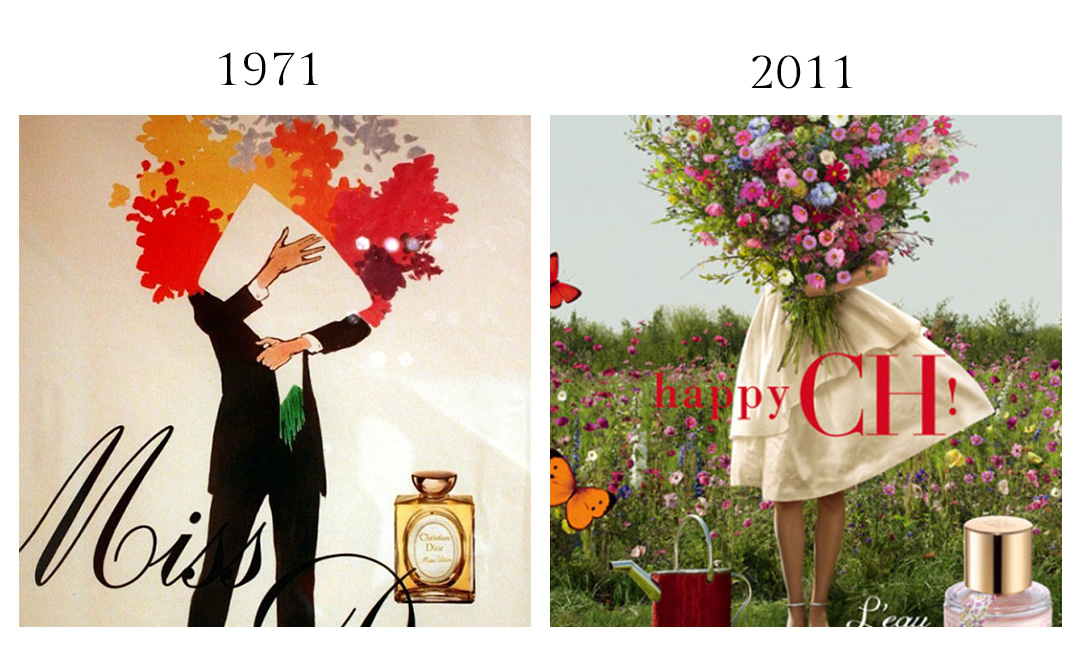
René Gruau and Koto Bolofo
René Gruau and Koto Bolofo
As Artistic Director of Advertising at Christian Dior, Gruau’s illustrations helped to define the beauty ideals of the period, creating imagery of the Dior woman from the inception of the label well into the 70s and 80s. In 1971, Gruau’s campaign for Miss Dior Cherie featured a first-ever male lead, carrying an oversized bouquet presumably to gift along with the fragrance. In 2011, photographer Koto Bolofo looked to Gruau’s work in creating his own fragrance campaign for CH L’eau by Carolina Herrera, however, Bolofo would opt for Rasa Zukauskaite instead of a tuxedoed man, perhaps suggesting women no longer need a man to buy a fragrance.
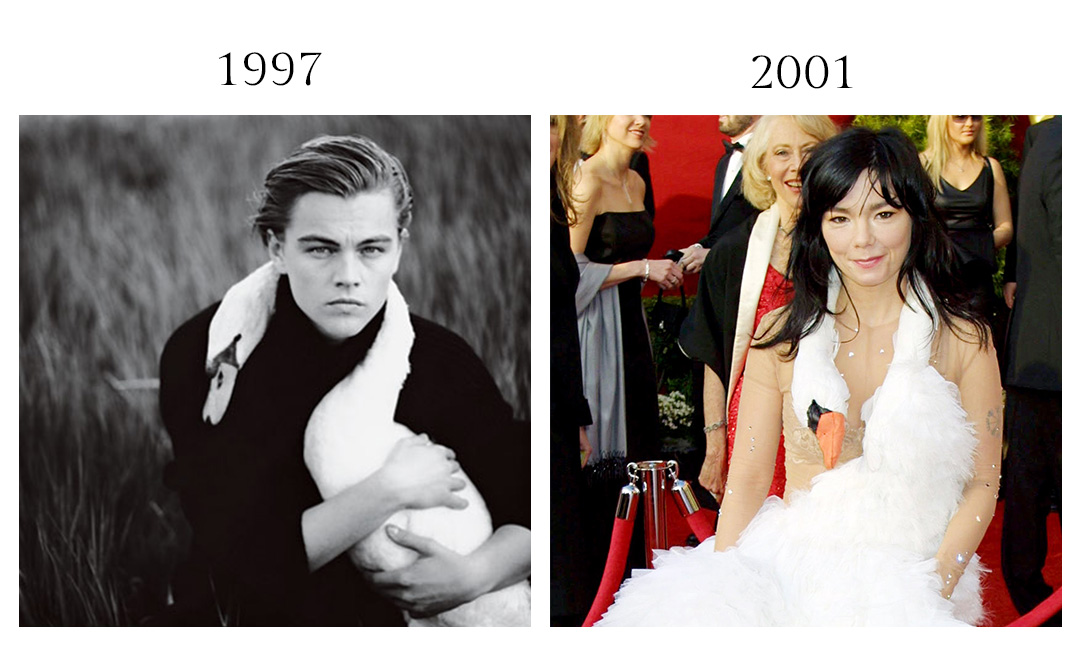
In 2001, Icelandic artist Björk wore what has now become one of the most infamous red carpet dresses. Designed by Macedonian Marjan Pejoski, the frock referred to as the “swan dress,” was meant to symbolize fertility, a notion further reinforced by Björk as she left a trail of eggs down the red carpet. While most viewed the dress as outlandish, perhaps it was not so unfamiliar to our eyes. A few years earlier in 1997, Annie Leibovtiz photographed then-budding actor Leonardo DiCaprio seemingly cuddling a swan that has looped its neck around that of the handsome film star for Vanity Fair.
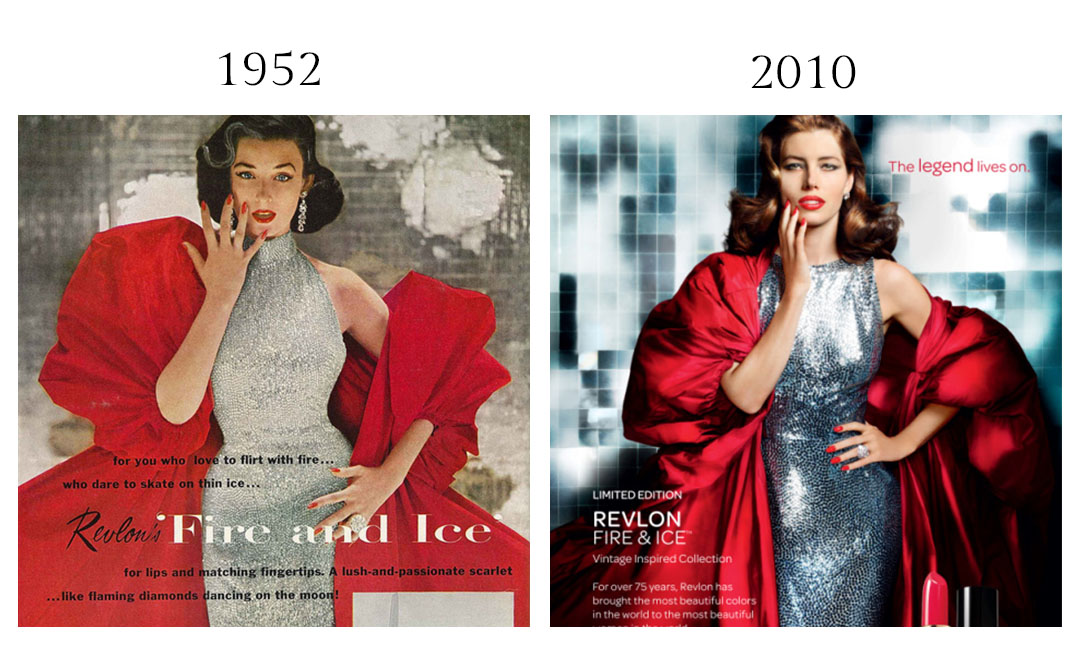
In 1952, Revlon introduced their striking Fire and Ice campaign photographed by Richard Avedon. Starring Dorian Leigh, the ad debuted the cosmetic brand’s latest pairings of matching “lips and tips” shades for those women “who love to flirt with fire…who dare to skate on ice.” Set against writer Kay Daly’s cheeky copy, the ad was the most talked-about campaign of its time, winning Advertising Age’s Ad of the Year accolade and subsequently dubbing Leigh the Fire and Ice girl. In the Avedon-shot campaign, Leigh was reportedly swathed in an unfinished Norman Norell-style mermaid gown, with sequins stopping just short at the back of the dress due to the meticulous hand-sewn sequin process which took longer than expected. The glittering gown, meant to evoke ice, was topped with an expansive fiery-red cloak copied from a Balenciaga original-a practice not uncommon in American fashion of the period. In 2010, Revlon rereleased three lip and tip pairings, celebrating with a campaign by Mario Testino that restaged the sensational 1952 ad with Jessica Biel standing in as Dorian Leigh.
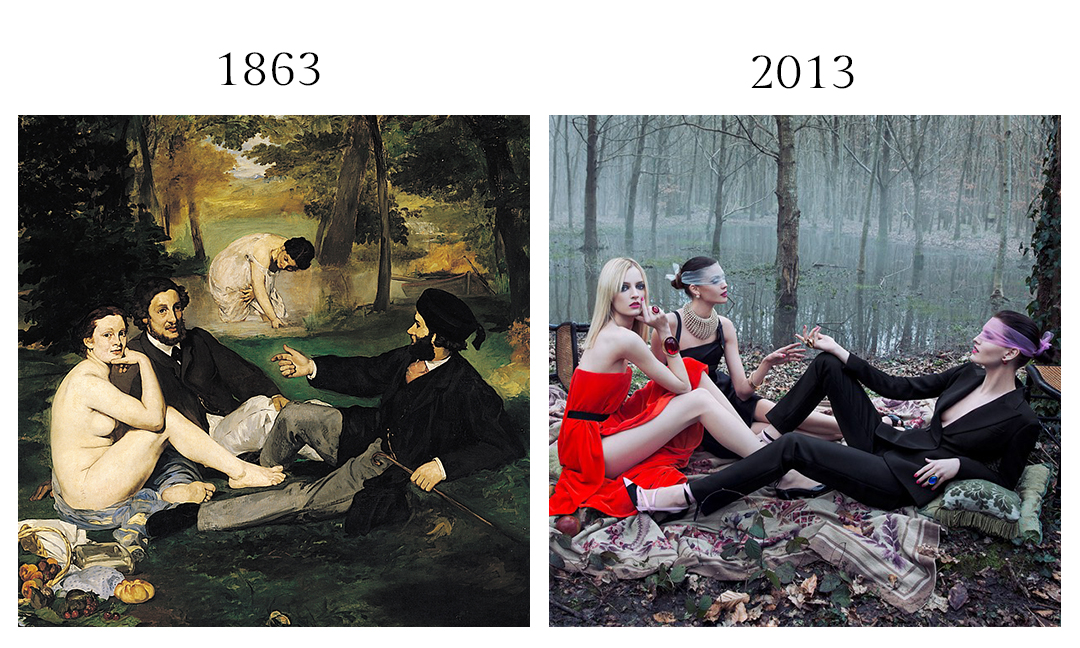
Originally titled Le Bain, Edouard Manet’s Le déjeuner sur l’herbe or Luncheon on the Grass, was debuted in 1863 to rather mixed reviews ranging from laughter to outrage. Although Manet’s titillating picnic scene was in reference to Titian’s 16th-century painting Concert champêtre, which featured a similar composition of nude females amongst dressed men, Manet’s figures where not represented in a mythological or allegorical manner. In Manet’s version, the men are dressed in contemporary fashions of the period, suggesting a jarring realism. Manet’s famous painting has been referenced by countless artists and photographers since its debut and continues to inspire to this day. In 2013, Dutch photographer team Inez van Lamsweerde and Vinoodh Matadin recreated the famous scene for Christian Dior’s Fall 2013 campaign video, “Secret Garden 2 - Versailles,” a sequel the previous year’s “Secret Garden” video.
+ много-много на сайте!
Аспирант делает проект по истории моды и изучает куда уходят корни фотографии моды, подбирая фотографические пары и снабжая их небольшими поясняющими текстами. Каждый может выбрать себе тему по душе и делать все тоже самое по аналогии.
Ссылка: http://partnouveau.com
Несколько примеров (полные изображения можно найти на сайте по ссылке, там примеров гораздо больше, чем здесь):

German photographer Erwin Blumenfeld’s Dada background is evident in his collage-like images and photographic manipulations. In 1943, Blumenfeld would place model Lisette behind a full-length panel of fluted glass, photographing her rippled, fragmented silhouette. In 2012, photographer duo Mert Alas and Marcus Piggott would employ a similar tactic in photographing Madonna’s MDMA Album cover.

A year after Yves Saint Laurent debuted his Mondrian-inspired shift dresses, the designer continued his appropriation of art into fashion with his Fall/Winter 1966-67 “Pop Art” dresses. This crop of dresses featured fragmented silhouettes of the female figure printed atop columnar shaped gowns, perhaps suggesting the nude body beneath the cloth. For Jean Charles de Castelbajac’s SS 2014 show, the designer would feature a dress with an uncanny resemblance to YSL’s 1966 version.

Showcasing the president’s popularity in the entertainment world, Esquire magazine’s June 1969 cover featured the newly elected President Nixon along with his celebrity backers including Art Linkletter, Billy Graham, Rudy Vallee & Lawrence Welk. The men pictured stand with welcoming arms, wide open with optimism as they praise their new leader. To celebrate the magazine’s 75th Anniversary, in 2008 British Esquire looked back to their celebrated Art Director George Lois and recreated several of his 60s covers. Contemporary fashion designers played along in the restaged images, with Karl Lagerfeld chosen to recreate the 1969 Nixon cover. In this version, the celebrity supporters were replaced with multiple images of Karl Lagerfeld himself-perhaps to say he may be his own biggest fan.

A year before the designer’s final collection, Cristóbal Balenciaga introduced his single-seam wedding dress in 1967. Balenciaga would take cues from the period’s affinity for futuristic cuts and tech fabrics, and in this case, reappropriated them into the unlikeliest of places, the traditional white wedding dress. With just one seam, the dress suggests it was born, rather than made, void of any elements that reveal the adroit human hands responsible for its existence. A similarly smooth monastic-like hood replaced the obvious white lace veil, making for a complete space age bride. In 2008, then-Balenciaga designer Nicolas Ghesquière looked to the house’s archives and reintroduced the mod headpiece for the brand’s SS 2008 collection. Four years later, the habit-like hat was once again brought back to life by Ghesquière for Balenciaga’s SS 2012 show, this time, however, the hood was offered up as a visor and was immediately stopped atop the heads of several daring fashion week fixtures.

In 1987, Herb Ritts photographed Madonna in bed and undressed, save for the pair of minnie mouse ears affixed atop her head. Amused, she directs her gaze upwards, focusing further attention on the seemingly out-of-place Disney memorabilia. For Elle Magazine’s May 2013 issue, Rita Ora covers the ”Women in Music Issue” issue, similarly topped with a pair of mouse ears, however, Ora’s Philip Treacy headpiece is more Deadmau5 than Minnie Mouse.

A contemporary of Salvador Dalí and Jean Cocteau, Elsa Schiaparelli’s transgressive designs were often inspired by the surrealists. A violet, satin evening coat was the result of Schiaparelli’s collaboration with Jean Cocteau in 1937 and was almost certainly the inspiration for a jacket seen on Miu Miu’s SS 2014 runways-almost a year after the Costume Institute’s exhibition, Schiaparelli and Prada: Impossible Conversations.

Vogue’s 1966 editorial, “The Girl in the Fabulous Furs” featured 26 pages of Veruschka swathed in exotic furs, traversing about Japan on the Bullet Train, (then, the world’s fastest train) along with her stay in a traditional Japanese inn where an additional room was required to house the abundant furs brought along the journey. In the editorial, the symbolic act of cutting hair was lightly restaged with a topless Veruschka seated and ready to be rid of her long hair. Further emphasizing the impact of a model’s change of appearance, Patrick Demarchelier documented Karlie Kloss’s transition from a long haired ingénue to a sophisticated gamine, which swiftly prompted several models and subsequently countless fashion conscious individuals to chop off several inches of their own hair.

Irving Penn and Mario Testino
With the return of the midi skirt, along with Raf Simons citing the Dior archives as the predominant inspiration behind his latest collection for the house, it seems a sense of mid-century glamour is having a moment. As Vogue’s leading photographer, Irving Penn’s sharp postwar imagery pierced the pages of the magazine in his signature high-contrast, black and white imagery. Penn’s unforgettable cover for the magazine’s April 1, 1950 issue features an immaculate Jean Patchett, enveloped in net and wrapped in a scarf, much like a life-sized New Look Barbie. For Vogue China’s December 2013 issue, Mario Testino would look back to Penn’s oeuvre with an editorial reminiscent of Penn’s early work at Vogue. Model Shu Qi plays the role of Jean Patchett, restaging some of Penn’s most well-known.

Inspired by Pina Bausch’s Ballet Keuschheitslegende, in which life-sized crocodiles creep around onstage amongst dancers, Helmut Newton would capture a ballerina-quite literally-in the belly of the beast, taking the transgressive ballet just a step further. For Vogue China’s 10th Anniversary issue, Mario Testino would photograph model Liu Wen also interacting with a crocidile, however, in the contemporary version, the woman seemingly dominates the animal rather than serving as its prey.

Belgian artist René Magritte toyed with perspective and reality, creating surreal works through real, ordinary settings and mundane objects. A common theme in Magritte’s work included the unsuspecting use and placement of clouds with an indistinguishable divide between grounded reality and fantastical skies. A Holger Trülzsch photograph of Veruschka from 1972 bears significant resemblance to Magritte’s 1946 work La magie noire.

A proponent of the Surrealist and Dada movements, Man Ray would build a prolific body of work as an artist and photographer. In 1926, Man Ray photographed Alice Ernestine Prin, better known as Kiki de Montparnasse, a social fixture of the Parisian bohemian scene of the 20s (and yes, the same Kiki who would later inspire the eponymous, uber-sexy lingerie brand). Representing the surrealist’s affinity for African Art, the photograph features Kiki’s resting head alongside that of a tribal African mask. Years later, the seminal Man Ray photograph would serve as inspiration to a fragrance campaign for Jean Paul Gaultier’s signature Classique. Photographed by Jean-Baptiste Mondino, the ad is currently on display at The Fashion World of Jean Paul Gaultier: From the Sidewalk to the Catwalk at the Brooklyn Museum.

As the uni-sex ruff became an increasingly pervasive component of Renaissance dress, women made an alteration to the demure neckpiece creating the open ruff as an alternative that showcased the woman’s bust. For Thom Browne’s SS 2014 collection, the designer would reappropriate several elements of historic costume including the women’s open ruff.

Fashion coverage throughout WWII placed high value on accessories amongst the wartime rations. When a new dress was not an option, the resourceful woman would change the ribbon on her hat to maintain a fresh look. With such focus placed on the trimmings of an ensemble, photographer John Rawlings would photograph just that with the amply accessorized hands and face of a disembodied model seemingly appearing out of nowhere.

A film that ranks top tier in any fashion lover’s list of all-time favorite films, Breakfast at Tiffany’s has provided endless source of fashion inspiration to designers and photographers. To this day, the film holds clout amongst the sartorially-minded and maintains an enduring ability to generate buzz. For Glamour Russia’s September 2011 issue, photographer Kenneth Willardt photographed model Maryna Linchuk posed as some of Hollywood’s most remembered leading lady protagonists, re-staging Breakfast at Tiffany’s brief music sequence in which a casual Holly Golightly sits perched atop her fire escape whilst serenading her neighbors with Moon River.

Following Man Ray’s lead, Philippe Halsman was a proponent of surreal photography with his elaborately orchestrated surreal scenes including his 1949 work Popcorn Nude recreated by Tim Walker in 2008. Walker often restages well-known photographs, adding his signature whimsical style to the overall composition. In this version, Halsman’s black and white is substituted with unexpected color in the least likely of places for Vogue UK‘s December 2008 issue in the editorial “Tales of the Unexpected,” which paid homage to Roald Dahl, creator of the most beloved children’s tales of the 20th century.

Following Man Ray’s lead, Philippe Halsman was a proponent of surreal photography with his elaborately orchestrated surreal scenes. Most remembered for his portraits of Albert Einstein and fellow surrealist Salvador Dalí, the Latvian-born Halsman would also photograph contemporary fashion. In 1947, Halsman would photograph the fall footwear fashions, depicting three pairs of disembodied legs sporting the latest shoe styles peeking out from underneath a curtain. In 2011, Karl Lagerfeld would photograph model Freja Beha in her the fifth consecutive campaign for Chanel. In the ad, only Beha’s stockinged legs are visible beneath the curtain of a photo booth, resembling Halsman’s photograph years earlier.

According to imperial dress codes under the Qing Dynasty, court officials and bureaucrats would don required red caps known as “Rites Hat.” Two styles of the hat were worn, the Nuan Mao and the Liang Mao, the former reserved for summer, consisting of a conically shaped red cap and the latter worn during winter featuring a black fur brim as pictured in Emperor Xianfeng’s portrait c. 1855. For his Fall 2012 collection, designer Jason Wu looked to his Chinese heritage, incorporating elements of Chinese traditional dress into his ready to wear collection.

A precursor to the contemporary crop of limited edition, collectable publications, La Gazette du Bon Ton, or the Journal of Good Taste, boasted hand-colored fashion plates and exclusive designer features at the steep annual subscription fee of 100 francs per year for the monthly publication. Along with the designs of couture houses Redfern, Doucet and Pacquin, orientalist designs by Paul Poiret were a frequent feature in the journal. Often times the fashions found in the Gazette were fanciful creations by illustrators like Georges Lepape, rather than literal translations of existing garments. Lepape’s fantastical fashion plate in 1914 depicts a Poiret dress in the style of the Sun King’s manicured garden’s. For their SS 2010 collection, Vikor and Rolf would design a similar dress that explored concepts of cutting down, shaving and trimming-taking a chainsaw to tulle.

Although his work often made up the pages of Vogue, William Klein rejected the label of fashion photographer, perceiving the association limiting and misrepresentative. Klein was also a painter, filmmaker and photographer with a somewhat cynical view of fashion; in 1966, Klein’s would famously satirize the cult of fashion in his film Qui êtes-vous, Polly Maggoo. In spite of this, Klein would go on to produce remarkable fashion imagery. For Vogue‘s July, 1 1967 issue, Klein would photograph the self-proclaimed ”exotic” model Veruschka alongside a chained cheetah to showcase two trends of the season: chains and animal skins. For Vogue Latin America‘s June 2013 issue, photographer Nagi Sakai celebrated the German model’s career by restaging several of her most well-known images with model Mirte Maas.

René Gruau and Koto Bolofo
René Gruau and Koto Bolofo
As Artistic Director of Advertising at Christian Dior, Gruau’s illustrations helped to define the beauty ideals of the period, creating imagery of the Dior woman from the inception of the label well into the 70s and 80s. In 1971, Gruau’s campaign for Miss Dior Cherie featured a first-ever male lead, carrying an oversized bouquet presumably to gift along with the fragrance. In 2011, photographer Koto Bolofo looked to Gruau’s work in creating his own fragrance campaign for CH L’eau by Carolina Herrera, however, Bolofo would opt for Rasa Zukauskaite instead of a tuxedoed man, perhaps suggesting women no longer need a man to buy a fragrance.

In 2001, Icelandic artist Björk wore what has now become one of the most infamous red carpet dresses. Designed by Macedonian Marjan Pejoski, the frock referred to as the “swan dress,” was meant to symbolize fertility, a notion further reinforced by Björk as she left a trail of eggs down the red carpet. While most viewed the dress as outlandish, perhaps it was not so unfamiliar to our eyes. A few years earlier in 1997, Annie Leibovtiz photographed then-budding actor Leonardo DiCaprio seemingly cuddling a swan that has looped its neck around that of the handsome film star for Vanity Fair.

In 1952, Revlon introduced their striking Fire and Ice campaign photographed by Richard Avedon. Starring Dorian Leigh, the ad debuted the cosmetic brand’s latest pairings of matching “lips and tips” shades for those women “who love to flirt with fire…who dare to skate on ice.” Set against writer Kay Daly’s cheeky copy, the ad was the most talked-about campaign of its time, winning Advertising Age’s Ad of the Year accolade and subsequently dubbing Leigh the Fire and Ice girl. In the Avedon-shot campaign, Leigh was reportedly swathed in an unfinished Norman Norell-style mermaid gown, with sequins stopping just short at the back of the dress due to the meticulous hand-sewn sequin process which took longer than expected. The glittering gown, meant to evoke ice, was topped with an expansive fiery-red cloak copied from a Balenciaga original-a practice not uncommon in American fashion of the period. In 2010, Revlon rereleased three lip and tip pairings, celebrating with a campaign by Mario Testino that restaged the sensational 1952 ad with Jessica Biel standing in as Dorian Leigh.

Originally titled Le Bain, Edouard Manet’s Le déjeuner sur l’herbe or Luncheon on the Grass, was debuted in 1863 to rather mixed reviews ranging from laughter to outrage. Although Manet’s titillating picnic scene was in reference to Titian’s 16th-century painting Concert champêtre, which featured a similar composition of nude females amongst dressed men, Manet’s figures where not represented in a mythological or allegorical manner. In Manet’s version, the men are dressed in contemporary fashions of the period, suggesting a jarring realism. Manet’s famous painting has been referenced by countless artists and photographers since its debut and continues to inspire to this day. In 2013, Dutch photographer team Inez van Lamsweerde and Vinoodh Matadin recreated the famous scene for Christian Dior’s Fall 2013 campaign video, “Secret Garden 2 - Versailles,” a sequel the previous year’s “Secret Garden” video.
+ много-много на сайте!